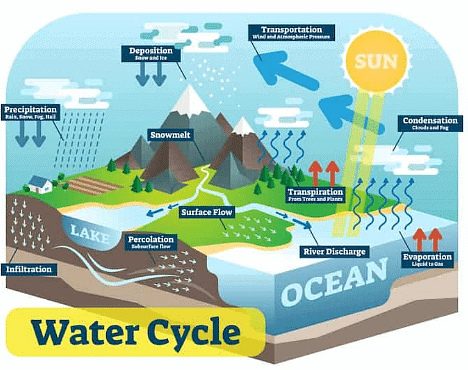UPSC Exam > UPSC Notes > Zoology Optional Notes for UPSC > Biosphere: Biogeochemical Cycles
Biosphere: Biogeochemical Cycles | Zoology Optional Notes for UPSC PDF Download
| Table of contents |

|
| Biogeochemical Cycles: Environmental Processes and Significance |

|
| Nutrient Cycling |

|
| Water (Hydrologic) Cycle |

|
| Carbon Cycle |

|
| Nitrogen Cycle |

|
| Sulphur Cycle |

|
| Calcium Cycle |

|
Biogeochemical Cycles: Environmental Processes and Significance
The biogeochemical cycle, a fundamental concept in environmental science, elucidates the exchange of essential nutrients and chemical elements between biotic and abiotic components of ecosystems. These cycles play a crucial role in maintaining ecological balance and sustaining life on Earth. In this comprehensive article, we will explore the intricacies of biogeochemical cycles, with a focus on the role they play in preparing for the UPSC Civil Service Exam.
Understanding Biogeochemical Cycles
- A biogeochemical cycle, also known as a nutrient cycle, is the continuous movement of chemical substances between the Earth's biotic and abiotic components.
- Biotic components encompass the atmosphere, hydrosphere, and lithosphere, while the biosphere is considered abiotic.
- Geology and chemistry are integral to understanding these cycles, as they revolve around the recycling of inorganic materials between living organisms and their environment.
Nutrient Cycling
- Nutrient cycles represent the mechanisms by which essential elements circulate and get recycled.
- These cycles involve cells, organisms, communities, and ecosystems, with their rates influenced by various biotic, physical, and chemical factors.
- Nutrient cycles in nature are often referred to as biogeochemical cycles, given their cyclical transfer of elements between the environment and living organisms.
Types of Nutrient Cycling
- Based on the Replacement Period:
- Perfect Cycle: Nutrients are replenished at the same rate as they are used, a characteristic primarily observed in gaseous cycles.
- Imperfect Cycle: Sedimentary cycles are characterized by nutrient loss, trapping certain elements in sediments and rendering them less immediately available.
- Based on the Nature of the Reservoir:
- Gaseous Cycle: In gaseous cycles, the atmosphere or hydrosphere serves as the primary reservoir.
- Sedimentary Cycle: Sedimentary cycles have the Earth's crust as their reservoir.
Gaseous Cycles
- Water, carbon, and nitrogen are three prominent examples of gaseous cycles.
Water (Hydrologic) Cycle
- The water cycle involves the continuous movement of water within the Earth-atmosphere system.
- Reservoirs for water include the atmosphere, oceans, lakes, rivers, soils, glaciers, snowfields, and groundwater.

- Processes like evaporation, transpiration, condensation, precipitation, deposition, runoff, infiltration, and groundwater flow drive the transfer of water between various reservoirs.
Carbon Cycle
- Carbon, primarily in the form of carbon dioxide (CO2), is prevalent in the atmosphere and continually exchanges between the atmosphere and organisms.

- Photosynthesis transports carbon from the atmosphere to green plants and, subsequently, to other organisms.
- Respiration and decomposition release carbon back into the atmosphere, constituting a relatively short-term cycle.
Nitrogen Cycle
- Nitrogen is a fundamental building block of living tissues and proteins, accounting for a significant portion of their composition.
- The nitrogen cycle comprises three key phases: nitrogen fixation, nitrification, and denitrification, involving the atmosphere, hydrosphere, and lithosphere.

- Nitrogen fixation, carried out by nitrogen-fixing bacteria, converts atmospheric nitrogen to ammonia (NH3), facilitating its incorporation into ecosystems.
- Nitrification and denitrification processes further transform nitrogen compounds, involving soil bacteria in their execution.
Sedimentary Cycles
- Sedimentary cycles, characterized by the Earth's crust as their primary reservoir, encompass elements such as iron, calcium, phosphorus, and sulfur.
- These cycles exhibit variations depending on the element and consist of a water-related phase and a sediment phase, often taking extended periods to complete.
Phosphorus Cycle
- The phosphorus cycle involves the circulation of phosphorus through rocks, water, soil, sediments, and living organisms.
- Rain and weathering release phosphate ions from rocks, making them available in soil and water.
- Plants take up inorganic phosphate from the soil, integrating it into organic molecules.
- Decomposition and mineralization processes release organic phosphate back into the soil, completing the cycle.
Sulphur Cycle
- Sulphur, found in rocks, oceanic sediments, and the atmosphere, circulates through natural and human-driven processes.
- Natural sources, like volcanic eruptions and microbial activities, contribute sulphur to the atmosphere.
- Human activities, particularly industrial processes, release sulphur dioxide and hydrogen sulphide gases into the air.
- These compounds can transform into sulphuric acid when reacting with water, contributing to the sulphur cycle.
Calcium Cycle
- Calcium primarily exists in rock, minerals, and structural forms within soil particles.
- Weathering of minerals or breakdown of organic materials by bacteria releases soluble calcium.

- Calcium is available to plants and microbes in the soil solution and is exchanged between them.
- Decomposers release calcium in a soluble form back into the soil after breaking down deceased organisms.
Significance of Biogeochemical Cycles
- Biogeochemical cycles are essential for converting nutrients into usable forms, facilitating their uptake by various organisms.
- These cycles maintain ecological balance by storing nutrients for future use and enable the transfer of elements between different locations, including from the atmosphere to the soil or water to soil.
- Biogeochemical cycles foster interactions between living organisms and their abiotic surroundings, contributing to ecosystem stability and sustainability.
The document Biosphere: Biogeochemical Cycles | Zoology Optional Notes for UPSC is a part of the UPSC Course Zoology Optional Notes for UPSC.
All you need of UPSC at this link: UPSC
|
181 videos|351 docs
|
Related Searches




















